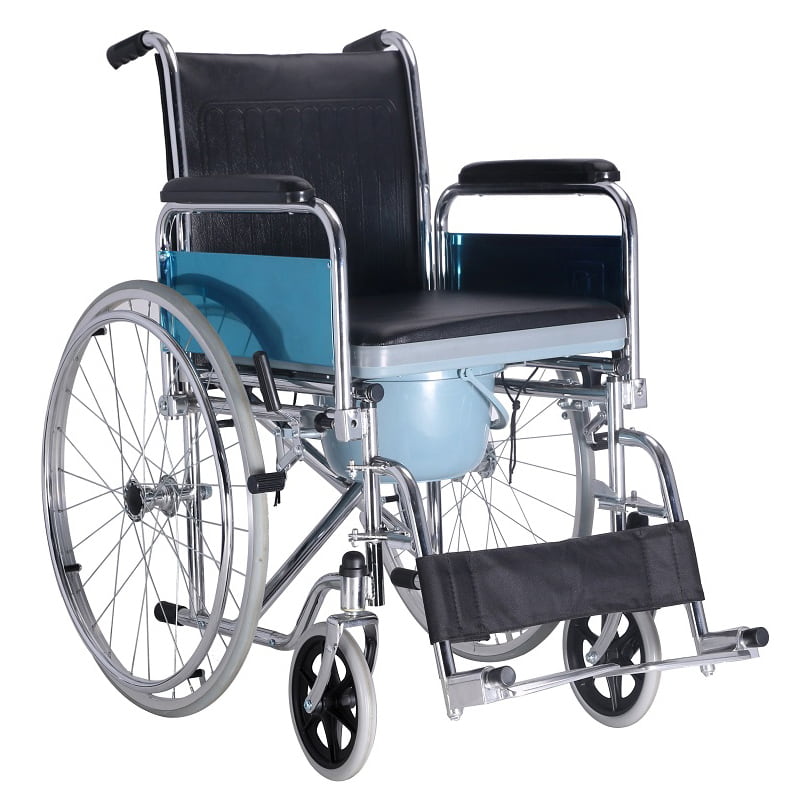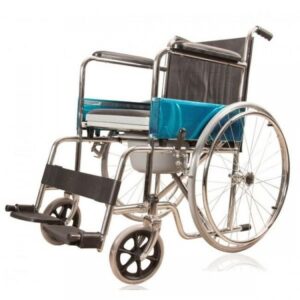A commode wheelchair is a specialized type of wheelchair that differs from a standard wheelchair in several key aspects. The primary distinction lies in its design and features, which are specifically intended to address the needs of individuals with limited mobility and certain medical conditions. Let’s explore the differences between a commode wheelchair and a standard wheelchair in detail:
- Purpose: The main purpose of a commode wheelchair is to provide a portable and convenient toileting solution for individuals with mobility challenges. It is designed to facilitate easy access to bathroom facilities, particularly for people with difficulties transferring from a wheelchair to a toilet.
- Built-in Commode: Unlike a standard wheelchair, a commode wheelchair incorporates a built-in commode system. It typically features a removable or folding seat with a hole in the center, allowing the user to access the commode bucket positioned underneath. This feature enables individuals with mobility limitations to use the wheelchair as a mobile toilet chair.
- Hygiene and Convenience: Commode wheelchairs often come equipped with additional features to enhance hygiene and convenience. These may include a splash guard or a commode pail with a lid, making it easier to maintain cleanliness and privacy during toileting. Some models even offer height-adjustable footrests and armrests to accommodate different user needs.
- Portability and Maneuverability: Commode wheelchairs are designed to be lightweight and portable, allowing for easy transportation and storage. They are often foldable for compactness and convenience during travel. Moreover, these wheelchairs are designed with smaller rear wheels or caster wheels, which make them more maneuverable in tight spaces like bathrooms.
- Durability and Weight Capacity: Due to the additional features and construction considerations, commode wheelchairs may have a slightly different build compared to standard wheelchairs. They are typically built to withstand heavier loads and have a higher weight capacity, ensuring the safety and stability of the user during transfers and toileting.
- Customization and Adjustability: Commode wheelchairs, like standard wheelchairs, can often be customized and adjusted to meet individual requirements. They may offer adjustable seat heights, removable armrests, or swing-away footrests, allowing for optimal comfort and functionality.
- Accessibility and Safety: Commode wheelchairs are designed with accessibility and safety in mind. They often have a lower seat height, making it easier for users to transfer onto and off the wheelchair. Additionally, they may have lockable brakes, anti-tipping features, and sturdy frames to ensure stability and prevent accidents during transfers and toileting.
It’s important to note that while commode wheelchairs provide a practical solution for individuals with specific toileting needs, they may not be suitable for everyone. Depending on an individual’s physical condition, a standard wheelchair or other assistive devices might be more appropriate. Consulting with healthcare professionals, such as occupational therapists or physicians, is crucial to determine the most suitable mobility solution for each individual.
In summary, a commode wheelchair differs from a standard wheelchair primarily in its purpose, built-in commode feature, hygiene conveniences, portability, durability, and adjustability. It serves as a versatile mobility aid that enables individuals with limited mobility to maintain independence and dignity while addressing their toileting needs.



